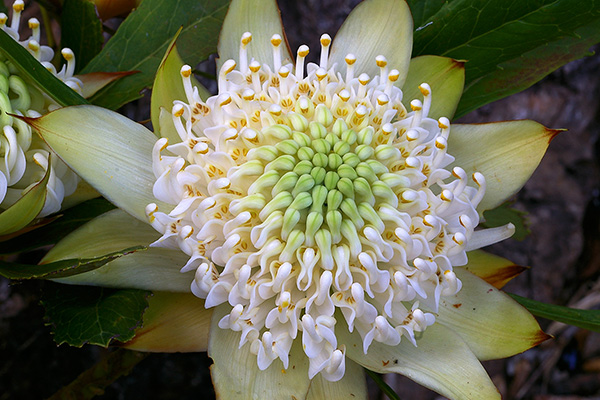
The White Waratah
Don Tilby
This article is over 20 years old and experience with the cultivation and propagation of the white flowered form of Telopea speciosissima has moved on. However, readers may be interested in the story of how the White Waratah, now known as 'Wirrimbirra White', came into cultivation and some of the early attempts at propagation.
The White Waratah was first discovered in 1967, by maintenance men from Nepean Depot of the then Sydney Water Board. When first seen it displayed eight beautiful blooms, five of these were picked, one was taken to Thirlmere Hotel, one to Tahmoor Hotel, one to Queen Victoria Hospital, Picton and the other two to the nurseryman at Nepean Depot.
Thistle Harris-Stead heard of the discovery and sought out the discoverer at the Thirlmere Hotel. He refused to divulge the whereabouts of the plant. Thistle later obtained this information from Assistant Forestry Officer, Red Mitchell.
Over the next years both Red and Thistle took limited cuttings from the plant and successful strikings were distributed to special interested people. A number were placed at Wirrimbirra Wildflower Sanctuary where they now bloom rather irregularly.
According to Ken Nony the plant produced one bloom the following year, but did not bloom again till 1979.
I first saw the plant in 1975, but did not see it in bloom till 1979, after it was burned to ground level by a wildfire in December 1977. Two blooms were produced this time but the branch broke off in high wind. I recovered the branch and gave it to Thistle Harris for cutting material.
It next bloomed in 1982 when three fine blooms were produced. Paul Nixon of Sydney University's Research Station, Camden was introduced to the 'white waratah club' in 1979, and was allowed limited cuttings. He produced plants from cuttings and grafts, but his main interest was in tissue culture. He reports very little success at tissue culture so far, but red waratahs propagate by this method readily.
 |
| Telopea speciosissima 'Wirrimbirra White' |
The original plant, as well as those which have bloomed elsewhere, have all failed to set seed pods. To try to overcome this problem, Paul Nixon had the idea that hand pollination might help, so when the plant produced three blooms in 1982, Paul instructed me in the hand pollination technique which had to be carried out approximately every three days as the outer stamens matured.
Four stamens were treated with pollen from a red Telopea speciosissima then capped with small sections of plastic drink straws, another four were treated with pollen from a yellow Telopea truncata (Paul had obtained a refrigerated bloom from Tasmania) and another four stamens on a nearby red waratah were treated with pollen from the white waratah. This was repeated on 10, 13, 16, 21, and 24th October, 1982. Each day was covered with a different coloured straw so development could be recorded.
Those treated on the white with red pollen on the 21st October produced three seed pods but they withered and died when less than 4 cm long. On the red treated with white pollen on the same day (21st) four seed pods were produced but were eaten by parrots or rats when about 5 cm long. No other pods were set. The programme was to be repeated, but as yet no further blooms have been set, and none will form this year (1984).
From the newsletter of the Blue Mountains Group of the Australian Plants Society, January 1985.
Australian Plants online - 2008
Association of Societies for Growing Australian Plants
|